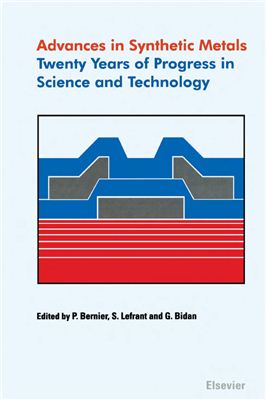Elsеvier Sciеnce, 1999, 458 pages
This edited work contains eight extensive, review-type contributions by leading scientists in the field of synthetic metals. The authors were invited by the organisers of the Inteational Conference on Science and Technology of Synthetic Metals '98 (ICSM'98) to review the progress of research in the past two decades in a unifying and pedagogical manner. The present work highlights the state-of-the-art of the field and assesses the prospects for future research.
This book presents a striking overview of the fast development, over the last quarter of the century, of a class of materials - organic metals - which did not practically exist before. Comprising stacking of flat molecules in rows of planes with relative charge transfer as well as doping of polymers or of the new fullerenes, these compounds, which require versatile methods of production, present a large variety of structures and properties. Their development was made possible by a remarkable collaboration of chemists and physicists, theoreticians as well as experimentalists, using, on the same compound, a variety of refined techniques.
20 Years of Synthetic Metals - the Role of Synthesis
Twenty Years of Conducting Polymers: From Fundamental Science to Applications
The Normal Phase of Quasi-One-Dimensional Organic Superconductors
Interplay of Structural and Electronic Properties
Organic Lower-Dimensional Crystalline and Monolayer Conductors
Electron Transport in Conducting Polymers
Inherently Conducting Polymers: Their Role in the Evolution of Intelligent Polymer Systems
Conducting Forms of Carbon: Fullerenes, Onions, Nanotubes
This edited work contains eight extensive, review-type contributions by leading scientists in the field of synthetic metals. The authors were invited by the organisers of the Inteational Conference on Science and Technology of Synthetic Metals '98 (ICSM'98) to review the progress of research in the past two decades in a unifying and pedagogical manner. The present work highlights the state-of-the-art of the field and assesses the prospects for future research.
This book presents a striking overview of the fast development, over the last quarter of the century, of a class of materials - organic metals - which did not practically exist before. Comprising stacking of flat molecules in rows of planes with relative charge transfer as well as doping of polymers or of the new fullerenes, these compounds, which require versatile methods of production, present a large variety of structures and properties. Their development was made possible by a remarkable collaboration of chemists and physicists, theoreticians as well as experimentalists, using, on the same compound, a variety of refined techniques.
20 Years of Synthetic Metals - the Role of Synthesis
Twenty Years of Conducting Polymers: From Fundamental Science to Applications
The Normal Phase of Quasi-One-Dimensional Organic Superconductors
Interplay of Structural and Electronic Properties
Organic Lower-Dimensional Crystalline and Monolayer Conductors
Electron Transport in Conducting Polymers
Inherently Conducting Polymers: Their Role in the Evolution of Intelligent Polymer Systems
Conducting Forms of Carbon: Fullerenes, Onions, Nanotubes

